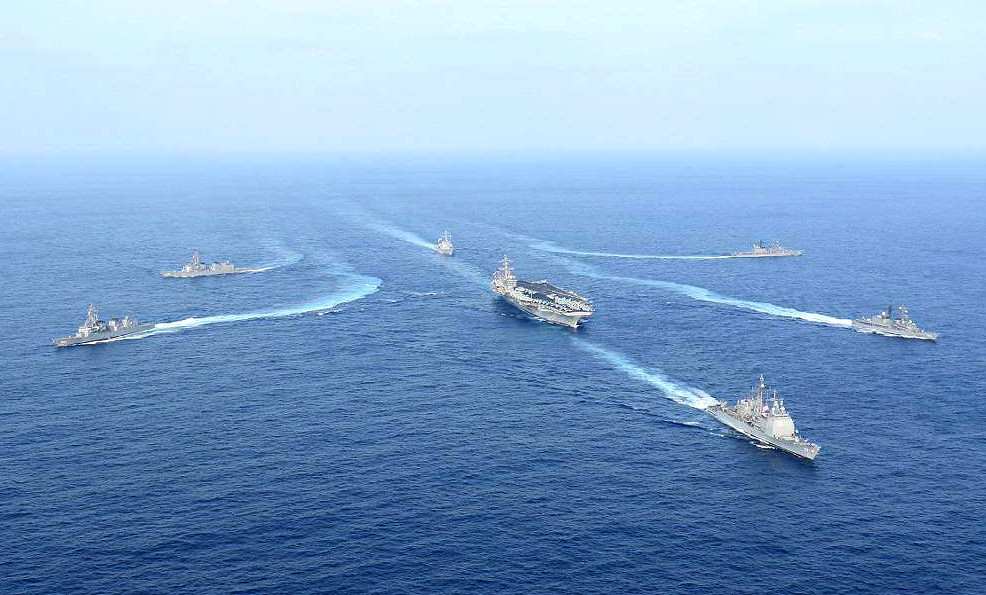From Carrier Strike Group 1 Public Affairs
Ships of the Carl Vinson Carrier Strike Group and JMSDF steam in formation, March 29. (JMSDF photo) >>
EAST CHINA SEA - Carl Vinson Carrier Strike Group and the Japan Maritime Self-Defense Force (JMSDF) concluded an at-sea bilateral exercise in the East China Sea, March 29.
The U.S. Navy and JMSDF operated together March 26-29 to increase proficiency in basic maritime skills and improve response capabilities.
Nimitz-class aircraft carrier USS Carl Vinson (CVN 70), Ticonderoga-class guided-missile cruiser USS Lake Champlain (CG 57) and Arleigh Burke-class guided-missile destroyer USS Wayne E. Meyer (DDG 108) were accompanied by JMSDF destroyers JS Hamagiri (DD-155), JS Samidare (DD-106), JS Sazanami (DD-113), JS Umigiri (DD-158) and JS Yudachi (DD-103).
The ships conducted multiple maneuvers testing their communications interoperability and ship handling techniques. The U.S. Navy and JMSDF routinely operate together to increase proficiency in basic maritime skills and improve response capabilities.
“The U.S. and Japan have built a relationship based on a shared vision of cooperation, democracy and regional stability,” said Rear Adm. Jim Kilby, commander, Carrier Strike Group 1. “The Japan-U.S. alliance is maintained and strengthened through training exercises like these.”
While deployed, CSG-1 is operating under U.S. 3rd Fleet command and control, including beyond the international dateline which previously divided operational areas of responsibility for 3rd and 7th Fleets.
“We, JMSDF, and the USN have confirmed matured relationships through this exercise,” said Rear Adm. Kajimoto Daisuke, commander, Escort Flotilla 3 (CCF-3). “All the bilateral operations with the U.S. Third Fleet were very successful. This achievement is reflecting well with continuous Seventh Fleet activities. This should be very significant for peace and stability in the region.”
The U.S. will continue its steadfast commitment and investment in the Indo-Asia-Pacific as a mutual commitment to the security and stability of the region. Third Fleet operating forward offers additional options to the Pacific Fleet commander by leveraging the capabilities of 3rd and 7th Fleets.
Bilateral training events improve teamwork, readiness and the capability to respond quickly to various situations in the region, ranging from disaster relief to maritime security activities.
CSG-1 departed San Diego for a regularly scheduled deployment to the western Pacific, Jan. 5. Carl Vinson, CVW 2 and embarked Destroyer Squadron (CDS) 1 deployed with Lake Champlain and Arleigh Burke-class guided-missile destroyers USS Michael Murphy (DDG 112) and Wayne E. Meyer.
CSG-1 deployed with approximately 6,500 Sailors and will focus on maritime security operations and theater security cooperation efforts. The strike group assets will conduct bilateral exercises in the Indo-Asia-Pacific region to include anti-submarine warfare, maneuvering drills, gunnery exercises and visit, board, search and seizure (VBSS) subject matter expert exchanges.

